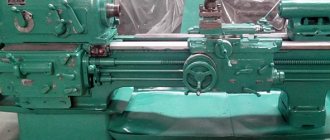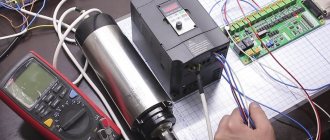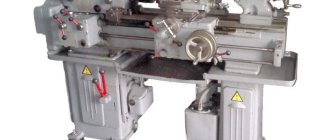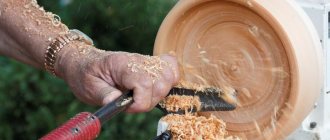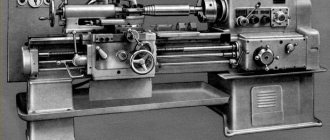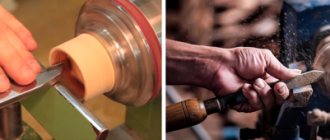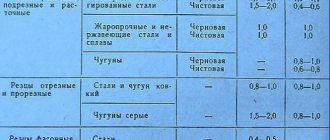The quality of the resulting parts depends on the thoughtfulness of each unit of a wood processing machine. The tailstock of a lathe plays a big role. It can be used ready-made, manufactured in production, or made independently in a home workshop.
History of origin
Direct analogues of modern lathes were invented in ancient times. The drive was initially manual, and then foot driven.
Wooden products were usually processed on such a machine. To begin metal processing, we had to improve the design.
First, they came up with a machine in which they replaced the need to manually hold the workpiece with a mechanical holder.
The most widely used lathes were manufactured at arms factories. There they were improved, a caliper, a lead screw, and a gear set were invented. The actual activation of the caliper has already been made automatic on some equipment models.
This is how equipment was produced until the beginning of the 20th century, and after the revolution a gearbox appeared. Allowing you to change the processing speed of the workpiece.
Electric motor for machine
The basis of the lathe drive is the engine. When choosing this unit, it is important to pay attention to its main characteristic – power. For a home machine, models with a power from 1200 to 2000 W are suitable. The type of connection is important; there are single-phase and three-phase motors.
In a low-power table lathe, you can use a motor from a washing machine. It is unlikely to cope with the processing of large workpieces, but it will help produce small decorative elements and kitchen utensils.
Device
The headstock is attached to the bed, as well as all the main parts of the machine and the tailstock. The main elements in all machines have an identical structure and a general operating principle.
Design elements:
- the fundamental framework where the controls and everything else are placed;
- quill – fastening component;
- one-piece metal body; a control lever that allows you to directly secure the quill and the base of the entire tailstock;
- a flywheel responsible for moving the quill;
- a screw with which the element is clearly secured in relation to the rest of the lathe and all its parts.
Since all the components are identical, the operating principle is not too different.
Principle of operation
The central part of the tailstock is attached to the caliper. Through it, the headstock receives translational motion, since it is equipped with an independent gear drive.
Some types of equipment produce rotational motion. The center of the tailstock itself does not rotate. The specific drive method depends on the modification of the machine, as well as on the tasks that need to be solved.
Node purpose
The main function is to securely secure the workpiece. The unit also supports the second edge of the workpiece and controls stable rotation.
When carrying out the drilling process, the tailstock is connected to the caliper, and a drill of the required size is inserted into the quill chuck.
Spindle
The name of this element comes from German and is translated as “spindle”. This part is a shaft that is equipped with a mechanism for fastening the workpiece that is being processed. Usually the shaft is made with a hole in which the rods are processed. The spindle neck is conical or cylindrical.
Basic standards for spindle operation:
- Wrapping accuracy - it is adjusted based on standards, and has a direct dependence on the purpose of the device itself, its accuracy.
- The rigidity of the spindle assembly itself - this requirement is also met based on generally accepted standards.
- Vibration resistance is in no way a determinant of the quality of the workpiece.
- Spindle speed - the higher the speed of this unit, the higher the quality of the finished product.
- Load-bearing capacity - this parameter almost entirely depends on the quality of the spindle supports and the fluid for lubricating the device.
- Durability - this item depends only on the quality of the bearings.
- Heat allowed for bearings.
One of the main conditions for the manufactured part to be processed as accurately and accurately as possible is the correct torsion of the spindle. It should rotate evenly and easily.
Headstock device
The main component of the front tank is the spindle. The spindle head is fixed to the left edge of the bed. This is the most important detail of the entire structure.
Various necessary fixtures, tools, and mandrels are fixed in the inner conical hole of the spindle.
How does it work
The movement of the spindle is transmitted from the V-belt pulley. All shafts and the spindle itself are mounted on rolling bearings.
When the machine rotates in a forward direction, large torques are required. This occurs due to the large number of discs that are located on the left side of the friction clutch.
If the gearbox is fixed in the bed frame, then it is connected to the spindle by a belt drive. Such equipment models are called split-drive machines.
What is it for?
The headstock carries out the main movement and transmits torque from the drive motor directly to the workpiece.
If the machine is universal, then the headstock, with the help of structural elements, drives the feed of the support with the cutting tool.
How to sharpen using the method of displacement relative to the axis of centers?
This method allows turning only external conical surfaces on a turning unit. In the process of making a cone using this technique, a misalignment of the center holes occurs. This method does not have the particular precision with which a conical surface can be created.
Important!
This method allows the use of mechanical caliper feed, which makes it possible to use simple types of units. The off-axis method makes it possible to create a long Morse cone.
Adjustment and repair
The adjustment includes the required steps:
- setting the amount of play that forms between the guides at the bed and the base of the tailstock;
- minimum clearances in the quill bearings if it rotates;
- eliminating the center offset relative to the spindle.
How often it is necessary to check and its procedure are indicated in the passport documentation for each machine.
If the need arises, restoration or repair work is carried out. The following parameters are restored:
- precise joining of the frame with the tailstock assembly;
- height of the spindle and quill.
It is also often necessary to restore the accuracy of the hole where the quill is attached.
Taper value
When considering taper, it should be taken into account that this indicator is directly related to the slope. This parameter determines the deviation of a straight line from a vertical or horizontal position. However, a 1:3 taper or a 1:16 taper is significantly different. The definition of slope is characterized by the following features:
- Slope refers to the ratio of the opposite side of a right triangle to the adjacent side. This parameter is also called the tangent of the angle.
- The following formula is used for calculation: i=AC/AB=tga.
This indicator can be calculated in a variety of ways; the most widely used formula is K=D/h. In some cases, the designation is carried out as a percentage, since this variable indicator is used to determine all other parameters.
DIY front and rear quill
The spindle head is a priori the most complex element of all equipment. During manufacturing, it is necessary to take into account that you will need a block of replaceable gears that transmit and change the speed of the rotational movement of the spindle and the torque directly from the gearbox shaft.
The tailstock is made with a movable or fixed center of rotation. For a movable version of the center, you will need to install a pair of bearings in the quill hole: the front edge with a conical roller, it will be thrust and the rear, radial, bored to a cone.
Installation and fixation of the rear center on the machine is carried out due to the conical hole of the sleeve. The spindle and thrust head are the basis of the design of any lathe.
Therefore, the master must know the principle of their operation, how to make such a part with his own hands and how to adjust it, and, if possible, repair it.
Restoration with acrylic plastic
- The hole for the spindle is expanded with the help of removing metal 3-4 millimeters thick. Ovality indicators should not exceed half a centimeter.
- A hollow frame is mounted in the headstock spindle. The outer diameter of the cylindrical mandrel is equal to the outer diameter of the updated quill.
- Relative to the quill axis, the mandrel is installed from the center. Before this, you should attach a special gasket (for example, made of paper) into the conical hole of the quill.
- After this, the runout corrections are tested and adjusted. The indicators should be in the region of 0.16-0.19 mm. Then the quill is mounted so that the forming mandrel is located above it with a slight deviation. This position of the part guarantees the difference in the height of the centers and the headstock at the required level (0.06-0.08 mm).
- Three small holes (about 7 mm in diameter) must be drilled above the spindle hole. They should be located in the middle and on the edges of the tailstock housing.
- The gap in the body is treated with a degreasing agent and dried for 25-30 minutes.
- The mandrel is treated with soap and the tailstock housing is mounted. The part must be secured to the frame using bolts.
- The hole for the quill should be sealed using special rings and plasticine. The same must be done with the holes for attaching the spindle.
- Three plasticine funnels are made above the previously made three holes.
- The previously prepared acrylic solution is poured into the middle funnel. It must be poured until the outermost funnels are partially filled.
- Then the tailstock treated with acrylic plastic is left to dry at a temperature of 19-20 degrees.
- After this, the assembly is shifted and cleaned of plasticine residues, special grooves are created, holes are made, a key-type groove is formed, and the entire tailstock structure is finally assembled.
The tailstock is one of the key components of a lathe. That is why every operator of such an installation must know the structure of this part and have minimal information about the most likely causes and “symptoms” of its failure. It is worth noting that even though the simplest unit breakdowns can be fixed on your own, it is always better to consult a specialist.
Republished by Blog Post Promoter
Formula for determining taper
You can independently calculate the taper by using various formulas. It is worth considering that in most cases the indicator is indicated in degrees, but it can also be expressed as a percentage - it all depends on the specific case. The calculation algorithm is as follows:
- K=Dd/l=2tgf=2i. This formula is characterized by the fact that the taper is characterized by a double slope. It is based on obtaining the value of the major and minor diameters, as well as the distance between them. In addition, the angle is determined.
- Tgf=D/2L. In this case, the length of the segment that connects the large and small diameters, as well as the indicator of the large diameter, is required.
- F=arctgf. This formula is used to convert the indicator to degrees. Today, in most cases, degrees are used, since they are easier to maintain when directly carrying out constructions. As for percentages, they are often indicated to enable the calculation of one of the diameters. For example, if the ratio is 20% and a smaller diameter is given, then you can quickly calculate the larger one.
As previously noted, the 1:5 taper and other indicators are standardized. For this, GOST 8593-81 is used.
Calculations are not shown in the drawing. As a rule, an additional explanatory note is created for this purpose. It is quite simple to calculate the basic parameters; in some cases, a drawing is constructed, after which the angle value and other indicators are measured.
Designation of taper in the drawing
When creating technical documentation, all established standards must be taken into account, otherwise it cannot be used in the future
When considering the taper designation in the drawings, attention should be paid to the following points:
- The diameter of the large base is displayed. The figure under consideration is formed by a body of rotation, which is characterized by a diametrical indicator. In the case of a cone, there may be several of them, and the change in the indicator occurs smoothly, not stepwise. As a rule, such a figure has a larger diameter, as well as an intermediate one if there is a step.
- The diameter of the smaller base is applied. The smaller base is responsible for forming the required angle.
- The length of the cone is calculated. The distance between the smaller and larger bases is an indicator of length.
- Based on the constructed image, the angle is determined. As a rule, appropriate calculations are carried out for this. In the case of determining the size from a printed image, using a special measuring device, the accuracy is significantly reduced. The second method is used when creating a drawing for the production of non-critical parts.
The simplest designation of taper also provides for displaying additional dimensions, for example, reference. In some cases, a taper sign is used, which makes it immediately clear about the difference in diameters.
There are quite a large number of different standards that relate to the designation of taper. The features include the following:
- The angle can be specified in degrees as a fraction or as a percentage. The choice is made depending on the area of application of the drawing. An example is that in the mechanical engineering field the value of a degree is indicated.
- In the mechanical engineering field, the concept of normal taper is included in a special group. It varies within a certain range and can be 30, 45, 60, 75, 90, 120°. Similar indicators are characteristic of most products that are used in the assembly of various mechanisms. At the same time, it is much easier to maintain such values when using turning equipment. However, if necessary, inaccurate angles can be maintained, it all depends on the specific case.
- When drawing the main dimensions, a drawing font is used. It is characterized by quite a large number of features that must be taken into account. Tabular information is used for correct display.
- To begin with, the taper icon is indicated from which the arrow is drawn and the value is displayed. The display features largely depend on what kind of drawing. In some cases, a large number of different sizes are applied, making taper application much more difficult. That is why it is possible to use several different methods for displaying such information.
In the drawing, the indicator in question is indicated in the form of a triangle. This requires a digital value that can be calculated using various formulas.
Read also: Not an integral part of a metal plane
How to make an internal cone on a lathe.
How to make an internal cone on a lathe. Help an inexperienced turner! You need to make a copy of the pulley, a seat with a cone. The original is lying on the table and I just can’t figure out how to make the same cone. There are no degree meters, and the degree on the machine will probably not be accurate. Are there any tricks to copy a cone?
How to make an internal cone on a lathe.
I would grind the mating part by lapping along the original hole, and then calmly sharpen the new one by fitting along the machined cone
How to make an internal cone on a lathe.
Zuvs, that's right.
How to make an internal cone on a lathe.
Clamp the sample into the chuck with the cone facing outward. Place an indicator on the small longitudinal lever. Unfold the small longitudinal one and move the indicator back and forth along the inner surface of the cone until you adjust the movement of the small longitudinal one parallel to the generatrix of the original cone. And then sharpen a new cone.
How to make an internal cone on a lathe.
https://www.internet-law.ru/gosts/gost/17554/ this is most likely a standard cone with a taper of 1/10
How to make an internal cone on a lathe. Sorry for ignorance, can anyone give a link or photo of what a lever indicator looks like? The cone fits on the crankshaft of the ud-2 engine. How to make an internal cone on a lathe. How to make an internal cone on a lathe. Here. How to make an internal cone on a lathe.
Got it, I'll have to get one of these!
How to make an internal cone on a lathe.
Ilfat (12 April 2012 — 21:12) wrote:
Got it, I'll have to get one of these!
if the machine has a cone ruler, then I advise you to sharpen along it, and not by turning the upper slide. How to make an internal cone on a lathe.
I heard about the cone ruler, but I didn’t see what it looks like, if it’s not difficult for anyone, please show me a photo.
How to make an internal cone on a lathe. Photo from the Internet.
Attached images
How to make an internal cone on a lathe. Thank you!
How to make an internal cone on a lathe.
Ilfat (12 April 2012 — 19:51) wrote:
measure the length of the cone, the smaller and larger diameter. Draw on paper, calculate the angle. How to make an internal cone on a lathe.
there is a formula d large minus d small (diameters) divided by 2 l, that is, the length of the cone multiplied by 2, we look for the resulting value in the table of tangents ..... there you adjust the resulting angle of the tool holder .... you'll figure out there is, of course, another geometric method, well, I think you'll figure it out
How to make an internal cone on a lathe.
MTZ-80, crankshaft cone dimensions UD-2: D=31.8; d=28; l=32. Taper according to the formula: tg2α=(Dd)/2l=(31.8-28)/64=0.0594. Angle α=1.7o
How to make an internal cone on a lathe. MTZ-80, when manufacturing a part, the fit may be a little tighter along a larger diameter, but not at a smaller one - it is checked by the print. How to make an internal cone on a lathe.
Yugra (10 December 2022 — 20:09) wrote:
crankshaft cone dimensions UD-2: D=31.8; d=28; l=32
Where does the information come from? Tyrnet says that 32.5x28.5x40 This is more like the truth, since the Gostovsky 1:10 turns out. How to make an internal cone on a lathe. MTZ-80, IMHO, don’t bother with a ruler or formulas, it won’t work out better than the indicator, especially since the machine probably isn’t of high accuracy. Be sure to take a magnetic stand for the indicator, or just a kit. like this: I don’t know how you work without it. The most necessary thing! Sharpen with low feed, it will probably wear out less. It will be more accurate. You need to measure strictly at the level of the cutter you will be processing. When measuring, first make sure that the cone does not hit the chuck either at the rear edge or at the front. Good luck.
Post edited by Mixxp: 11 December 2022 — 05:06
How to make an internal cone on a lathe.
Kuvaldych, if we bore the pulley to this size, we rest the hub against the cover bolts. At one time I had to do this kind of work quite often.
www.chipmaker.ru
Safety precautions
The work will be enjoyable and will not cause injury only if the turner knows and follows safety rules.
Work is performed only in protective clothing. Long hair must be tied back and there should be no hanging jewelry on clothing.
The machine must be reliably grounded. Turning equipment must undergo regular inspections.
Before turning on the machine, you need to check that the workpiece is securely fastened. Under no circumstances should objects be passed through a running machine.
In addition to the written rules, there is one more, unwritten one - do not be afraid of the machine, it is just a tool. If you adhere to this rule and work hard, you can easily become a real professional turner. A little effort, faith in the result and any detail that comes out from under the cutter will become a real creation of a master.
Posted by Sv7, January 11, 2014 in Conversations
Christmas trees made of cardboard
Small tabletop cardboard Christmas trees are an excellent New Year's decor. To strengthen crafts, you can make them by gluing 2-3 layers of cardboard. The work process follows the same principle as with plywood Christmas trees, only instead of a jigsaw or saw we use scissors. We decorate the trees with miniature toys, ribbons, bows, etc.
Wrapping with twine is a simple decoration. You can attach a magnet to the back of the craft.
Christmas trees made of cardboard, covered with burlap. Decorations - beads, lace ribbons, bouquets of artificial flowers. We attach the triangle to a straight branch that will imitate a trunk. We plant a Christmas tree in a pot.
You can cover Christmas trees with fabric of any color
It is important that the decorations contrast with the background
An option for decorating a cardboard Christmas tree is cotton papier mache. It’s simple: we glue layers of cotton wool onto a cardboard base using PVA glue.
Christmas trees from pots
The simplest New Year's crafts. You will only need:
- flower pots of different sizes;
- dye;
- small toys for decoration - stars, flowers, etc.
We paint the pots - not necessarily with green paint, because the Christmas tree is decorative. When the paint is dry, glue on the decor. To increase the stability of the Christmas trees, you can insert some kind of pin or thin round stick through the drainage holes in them.
If you don’t want to make anything (or don’t have time for it), we use the pot as a container in which we plant a spruce branch. It will be enough to decorate the top of a small New Year's tree with a star.

